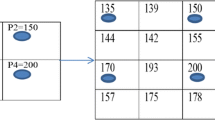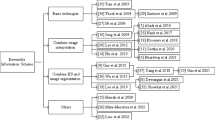Abstract
This research proposes a novel high-capacity-based reversible data embedding strategy for e-healthcare applications. The proposed reversible embedding scheme for electronic patient records (EPR) replaced the conventional embedding and interpolation techniques with a simple pixel-to-block-level transformation, repeated pixel differencing (RPD) and conditional pixel permutation (CPP) strategies. A fragile watermark image combined with EPR is employed to identify tamper detection in medical stego-images. In the proposed pixel-to-block conversion, a pixel is replicated to a 2 × 2 pixel block to facilitate the reversibility of EPR data. For embedding, RPD determines and adjusts the 2 × 2 pixel differences based on EPR and watermark data. Further, to ensure high imperceptibility for the human visual system proposed scheme computes the average value of pixels that must similar to the seed pixel. To maintain a histogram invariant stego-images, a permutation of 2 × 2 pixels is employed to embed additional secret data bits while exploiting the CPP strategy. The proposed scheme is extensively evaluated on + 2000 images regarding embedding capacity, perceptual imperceptibility, and tamper detection while employing different image processing attacks. Experimental results show that the proposed scheme achieved an average of 2.24 bpp with 41.27 dB PNSR on medical images and 2.49 bpp with 40.68 PSNR with general images. The proposed strategy outperformed existing approaches in terms of high embedding capacity, acceptable visual imperceptibility, and tamper detection while ensuring the 100% reversibility of EPR data in medical images.

















Similar content being viewed by others
Data availability
Data sharing not applicable to this article as no datasets were generated or analyzed during the current study.
References
Abadi MAM, Danyali H, Helfroush MS (2010) Reversible watermarking based on interpolation error histogram shifting. In 2010 5th International Symposium on Telecommunications (pp. 840–845). IEEE
Akintunde TY, Akintunde OD, Musa TH, Sayibu M, Tassang AE, Reed LM, Chen S (2021) Expanding telemedicine to reduce the burden on the healthcare systems and poverty in Africa for a post-coronavirus disease 2019 (COVID-19) pandemic reformation. Global Health Journal 5(3):128–134
Bhardwaj R, Aggarwal A (2019) Hiding clinical information in medical images: an encrypted dual-image reversible data hiding algorithm with base-3 numeral framework. Optik 181:1099–1112
Chang Q, Li X, Zhao Y, Ni R (2021) Adaptive pairwise prediction-error expansion and multiple histograms modification for reversible data hiding. IEEE Trans Circuits Syst Video Technol 31(12):4850–4863
Chen YC, Shiu CW, Horng G (2014) Encrypted signal-based reversible data hiding with public key cryptosystem. J Vis Commun Image Represent 25(5):1164–1170
Dissent (2020) Leon Medical Center confirms ransomware attack, credits employees and staff with providing quality care despite attack. https://www.databreaches.net/leon-medical-center-confirms-ransomware-attack-credits-employees-and-staff-with-providing-quality-care-despite-attack/. Accessed 29 Dec 2020
Dissent (2020) Almost 11 million patients impacted by Blackbaud incident — and still counting. https://www.databreaches.net/almost-11-million-patients-impacted-by-blackbaud-incident-and-still-counting/. Accessed 20 Dec 2020
Elhoseny M, Abdelaziz A, Salama AS, Riad AM, Muhammad K, Sangaiah AK (2018) A hybrid model of internet of things and cloud computing to manage big data in health services applications. Futur Gene Comput Syst 86:1383–1394
Gao G, Wan X, Yao S, Cui Z, Zhou C, Sun X (2017) Reversible data hiding with contrast enhancement and tamper localization for medical images. Inf Sci 385:250–265
Hassan FS, Gutub A (2021) Efficient image reversible data hiding technique based on interpolation optimization. Arab J Sci Eng 46(9):8441–8456
Hick JL, Biddinger PD (2020) Novel coronavirus and old lessons—preparing the health system for the pandemic. N Engl J Med 382(20):e55
Hoover A (n.d.) Structured Analysis of the Retina. http://cecas.clemson.edu/~ahoover/stare/. Accessed 1 Jan 2021
Hou J, Ou B, Tian H, Qin Z (2021) Reversible data hiding based on multiple histograms modification and deep neural networks. Signal Process: Image Commun 92:116118
Hussain M, Riaz Q, Saleem S, Ghafoor A, Jung K-H (2021) Enhanced adaptive data hiding method using LSB and pixel value differencing. Multimed Tools Appl 80:20381–20401
Hussain M, Wahab AWA, Javed N, Jung KH (2018) Recursive information hiding scheme through LSB, PVD shift, and MPE. IETE Tech Rev 35(1):53–63
Hussain M, Wahab AWA, Idris YIB, Ho AT, Jung KH (2018) Image steganography in spatial domain: a survey. Signal Process Image Commun 65:46–66
Jung KH, Yoo KY (2009) Data hiding method using image interpolation. Comput Stand Interfaces 31(2):465–470
Kat J (2021) Banner Health agrees to pay $200k to settle potential HIPAA violations. https://www.healthcareitnews.com/news/banner-health-agrees-pay-200k-settle-potential-hipaa-violations. Accessed 15 Mar 2021
Kaw JA, Loan NA, Parah SA, Muhammad K, Sheikh JA, Bhat GM (2019) A reversible and secure patient information hiding system for IoT driven e-health. Int J Inf Manage 45:262–275
Kumar V, Pathak V, Badal N, Pandey PS, Mishra R, Gupta SK (2022) Complex entropy based encryption and decryption technique for securing medical images. Multimed Tools Appl 81(26):37441–37459
Kundu MK, Das S (2010) Lossless ROI medical image watermarking technique with enhanced security and high payload embedding. In 2010 20th International Conference on Pattern Recognition (pp. 1457–1460). IEEE
Lee CF, Huang YL (2012) An efficient image interpolation increasing payload in reversible data hiding. Expert Syst Appl 39(8):6712–6719
Lee CF, Huang YL (2013) Reversible data hiding scheme based on dual stegano-images using orientation combinations. Telecommun Syst 52(4):2237–2247
Liu Y, Qu X, Xin G (2016) A ROI-based reversible data hiding scheme in encrypted medical images. J Vis Commun Image Represent 39:51–57
Loan NA, Parah SA, Sheikh JA, Akhoon JA, Bhat GM (2017) Hiding electronic patient record (epr) in medical images: A high capacity and computationally efficient technique for e-healthcare applications. J Biomed Inform 73:125–136
Lu TC, Chi LP, Wu CH, Chang HP (2017) Reversible data hiding in dual stego-images using frequency-based encoding strategy. Multimed Tools Appl 76(22):23903–23929
Luo L, Chen Z, Chen M, Zeng X, Xiong Z (2009) Reversible image watermarking using interpolation technique. IEEE Trans Inf Forensics Secur 5(1):187–193
Mansour RF, Parah SA (2021) Reversible data hiding for electronic patient information security for telemedicine applications. Arab J Sci Eng 46(9):9129–9144
Meenpal A, Majumder S, Oruganti M (2022) Pixel value splitting based reversible data embedding scheme. Multimed Tools Appl 81(28):40535–40560
Naheed T, Usman I, Dar A (2011) Lossless data hiding using optimized interpolation error expansion. In 2011 Frontiers of Information Technology (pp. 281–286). IEEE
Naheed T, Usman I, Khan TM, Dar AH, Shafique MF (2014) Intelligent reversible watermarking technique in medical images using GA and PSO. Optik 125(11):2515–2525
Nguyen TS, Huynh VT, Vo PH (2022) A Novel Reversible Data Hiding Algorithm Based on Enhanced Reduced Difference Expansion. Symmetry 14(8):1726
Open i (n.d.) Open Access Biomedical Image Search Engine https://openi.nlm.nih.gov/. Accessed 1Jan 2021
Ossebaard HC, Van Gemert-Pijnen L (2016) eHealth and quality in health care: implementation time. Int J Qual Health Care 28(3):415–419
Parah SA, Ahad F, Sheikh JA, Bhat GM (2017) Hiding clinical information in medical images: A new high capacity and reversible data hiding technique. J Biomed Inform 66:214–230
Parah SA, Sheikh JA, Akhoon JA, Loan NA (2020) Electronic Health Record hiding in Images for smart city applications: A computationally efficient and reversible information hiding technique for secure communication. Futur Gener Comput Syst 108:935–949
Schaefer G, Stich M (2004) UCID: an uncompressed color image database. Electronic Imaging, San Jose, pp 472–480
Singh AK, Thakur S, Jolfaei A, Srivastava G, Elhoseny MD, Mohan A (2021) Joint encryption and compression-based watermarking technique for security of digital documents. ACM Trans Internet Technol (TOIT) 21(1):1–20
Southwick R (2022) The 10 biggest health data breaches in the first half of 2022. https://www.chiefhealthcareexecutive.com/view/the-10-biggest-health-data-breaches-in-the-first-half-of-2022. Accessed 1 Nov 2022
Tang M, Hu J, Song W (2014) A high capacity image steganography using multi-layer embedding. Optik 125(15):3972–3976
U.S. Department of Health & Human Services, Health Insurer Pays $6.85 Million to Settle Data Breach Affecting. (2020). healthcareitnewscom. https://www.hhs.gov/hipaa/for-professionals/compliance-enforcement/agreements/premera/index.html. Accessed 14 Jan 2021
Weber AG (1997) The USC-SIPI image database version 5. USC-SIPI Report 315(1). http://sipi.usc.edu/database/database.php?volume=misc/. Accessed 1 Nov 2022
Yang Y, Zhang W, Liang D, Yu N (2016) Reversible data hiding in medical images with enhanced contrast in texture area. Digital Signal Process 52:13–24
Zhang C, Ou B, Li X, Xiong J (2022) Human visual system guided reversible data hiding based on multiple histograms modification. Comput J 66(4):888–906
Acknowledgements
This research was supported by the National University of Sciences and Technology (NUST) under the Department of Computing, School of Electrical Engineering and Computer Science, Islamabad, Pakistan. This research was supported by Brain Pool program funded by the Ministry of Science and ICT through the National Research Foundation of Korea (2019H1D3A1A01101687) and Basic Science Research Program through the National Research Foundation of Korea (NRF) funded by the Ministry of Education (2021R1I1A3049788).
Author information
Authors and Affiliations
Corresponding authors
Ethics declarations
Conflicts of interest
The authors declare no conflicts of interest.
Additional information
Publisher's note
Springer Nature remains neutral with regard to jurisdictional claims in published maps and institutional affiliations.
Rights and permissions
Springer Nature or its licensor (e.g. a society or other partner) holds exclusive rights to this article under a publishing agreement with the author(s) or other rightsholder(s); author self-archiving of the accepted manuscript version of this article is solely governed by the terms of such publishing agreement and applicable law.
About this article
Cite this article
Aftab, H., Hussain, M., Riaz, Q. et al. Hiding EPR and watermark in medical images using repeated pixel differencing. Multimed Tools Appl 83, 43577–43605 (2024). https://doi.org/10.1007/s11042-023-15434-6
Received:
Revised:
Accepted:
Published:
Issue Date:
DOI: https://doi.org/10.1007/s11042-023-15434-6




